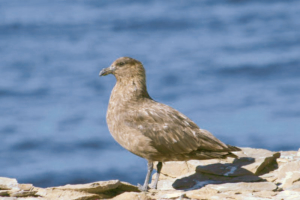This article was published in the Polar Biology journal in September 2019.
It deals with the predation of two species of marine birds, the Blue Petrel and the Thin-billed Prion, by brown skuas in the Kerguelen Islands.
You can access on the Tour du Valat web documentary portal here [1].

Abstract: Skuas are top predator and scavenger seabirds in marine and terrestrial ecosystems and monitoring their diet can provide valuable insights on the abundance and distribution of prey. The diet of the brown skua was studied at Mayes Island, Kerguelen archipelago, by collection of prey remains during their breeding cycle in 2013. We investigated a potential diet shift by comparing our results to those obtained two decades ago at the same colony. Our results confirmed the high specialisation of this skua colony in active predation of two burrowing petrels: the blue petrel and the thin-billed prion. We observed a shift in the diet of the brown skua with the importance of the thin-billed prion dropping significantly by 15%. Concomitantly, we observed a decreasing trend of burrow occupancy of the two main preys, with a more severe decline for the thin-billed prion. We suspected a dietary shift of brown skuas at Mayes Island related to a change in the relative abundance of blue petrels and thin-billed prions. Diet of brown skuas appears to be a valuable indicator of the relative abundance of burrowing petrels when they constitute the main food resource during breeding.
Bibliographical reference: Pacoureau N., Gaget E., Delord K., Barbraud C. 2019. Prey remains of brown skua is evidence of the long-term decline in burrow occupancy of blue petrels and thin-billed prions at Mayes Island, Kerguelen. Polar Biology 42:1873–1879. doi: 10.1007/s00300-019-02567-4